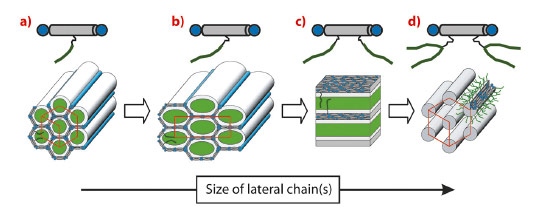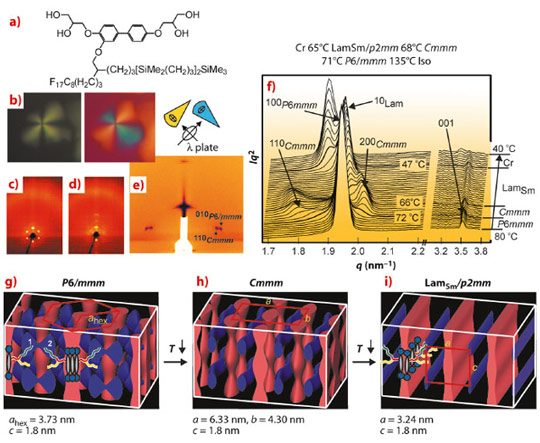- Home
- Users & Science
- Scientific Documentation
- ESRF Highlights
- ESRF Highlights 2012
- Soft condensed matter
- New 2-D and 3-D liquid crystal phases: Segmented cylinders, crossed columns and ribbons between sheets
New 2-D and 3-D liquid crystal phases: Segmented cylinders, crossed columns and ribbons between sheets
In recent years a new type of liquid crystal molecules, pioneered by C. Tschierske, gained prominence, having flexible chains attached to the side of the aromatic rods. With sticky hydrogen-bonding groups at the ends of the rod, these T-shaped “bolaamphiphiles” (Figure 81 a,b) were found to assemble in a range of new structures, many of which can be described as honeycombs [1]. The rods form the walls and the side chains fill the channels. In a recent study using grazing-incidence small-angle X-ray scattering (GISAXS) at beamline BM28 (XMaS) three new types of liquid crystals have been discovered.
 |
|
Fig. 81: Some representative LC structures in bolaamphiphiles with increasing volume of the side chains. Blue: hydrogen-bonding glycerol groups; grey: aromatic rod-like cores; green: laterally attached chains. |
By increasing the volume of the side-chain of the T-shaped molecules, the shape of the honeycomb cells can be changed from triangular, via rhombic, square, pentagonal all the way to stretched hexagonal, as more and more rods are required to encircle the cell – Figure 81 a,b. A further increase in side chain volume, e.g. by attaching two chains instead of one, makes the honeycombs give way to layered structures – Figure 81c. The work highlighted here has gone a step further by replacing the linear side-chains with branched “swallow-tail” ones (Figures 81d and 82a).
Interestingly, such compounds exhibit the hexagonal columnar phase again. However, this time the structure is an inverted honeycomb, in fact it is closer to the classical columnar discotic, with the columns having a hard aromatic centre and a soft aliphatic sheath. But unlike the discotic, the new columnar phase is made up of bundles of around 14 rod-like molecules in cross-section, with the rods aligned parallel to the column. The flexible side-chains provide the surrounding continuum (Figure 81d). The axial alignment of the rods is confirmed by the distribution of colours in polarised optical micrographs using an optical compensator (Figure 82b).
The compound used in this work has a lateral chain with two incompatible branches, a fluorinated (RF) and a carbosilane one (RSi) (Figure 82a). At high temperatures the rod-like molecules group together forming periodic modulation of the columns, as seen in the electron density map in Figure 82g (red), reconstructed from X-ray diffraction. The weak but distinct Bragg reflection at q = 3.5 nm-1 indexed as (001) (Figure 82f) indicates true 3-D-ordered packing of molecular bundles, with P6/mmm symmetry. Each bundle is centred at a vertex of a simple 3-D hexagonal unit cell (see Figures 82g and 81d).
On cooling, a transition to a lamellar phase takes place (see Figure 82d) via an intermediate orthorhombic LC phase Cmmm (for the complete SAXS cooling series see Figure 82f and the GISAXS pattern in Figure 82e). The molecular bundles are in fact ribbons, rotating in the hexagonal phase but locked in the orthorhombic Cmmm (Figure 82h). Figure 82h also shows the presence of undulating RF-rich columns running perpendicular to the main aromatic columns. Thus, this crossed column mesophase consists of two orthogonal interpenetrating sets of columns, one segmented and the other undulated. On further cooling, in the LamSm/p2mm phase the ribbons fuse to form infinite sheets. In the lamellar phase the RF-rich columns remain, but change from undulated to straight. Thus, the LamSm phase contains fluorinated columns intercalated between aromatic sheets (Figure 82i).
In summary, three new LC phases were discovered with decreasing temperature, each with an intriguing structure: a hexagonal 3-D phase with correlated modulated columns, a 3-D phase with crossed columns, and a phase with columns between layers. This work illustrates the fact that there is much more yet to be discovered in liquid crystals. There has been a flurry of discoveries of new and ever more complex structures with great promise of new nanomaterials for optics and molecular electronics, photovoltaics, LEDs, ceramics templating and other applications.
Principal publication and authors
F. Liu (a), M. Prehm (b), X. Zeng (a), G. Ungar (a) and C. Tschierske (b), Angew. Chem. Int. Ed. 50, 10599–10602 (2011).
(a) Department of Materials Science and Engineering, University of Sheffield (UK)
(b) Institute of Chemistry, Martin-Luther-University Halle-Wittenberg, Halle (Germany)
References
[1] G. Ungar, C. Tschierske, V. Abetz, R. Holyst, M.A. Bates, F. Liu, M. Prehm, R. Kieffer, X. Zeng, M. Walker, B. Glettner and A. Zywocinski, Adv. Funct. Mater. 21, 1296-1323 (2011).
Acknowledgements
This work was supported by the EC 7th and 6th Framework Programmes, under contracts 2007-2013 (NANOGOLD, grant agreement n°228455), and ERAS-CT-2003-989409. It was also supported by DFG and EPSRC as part of the ESF EUROCORES Programme SONS.




